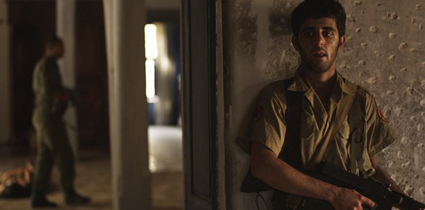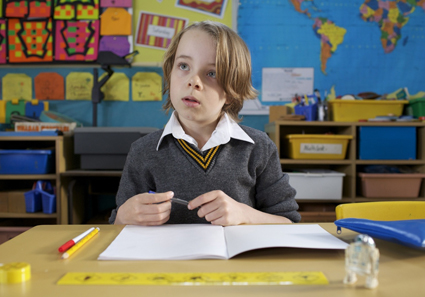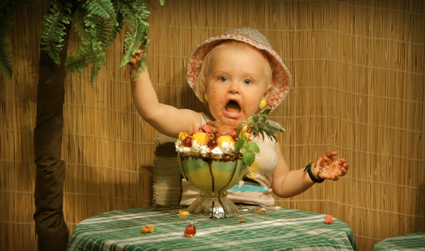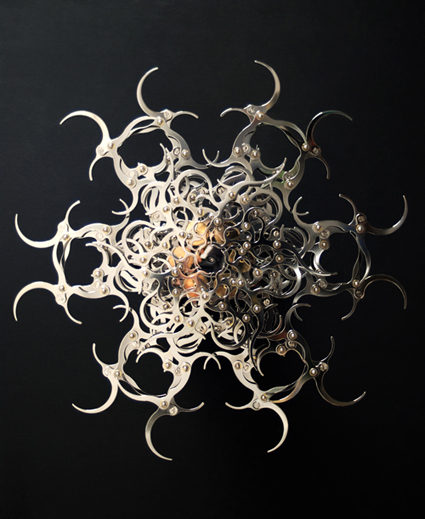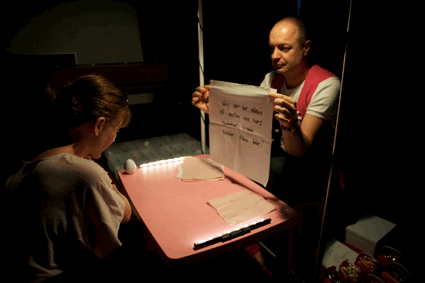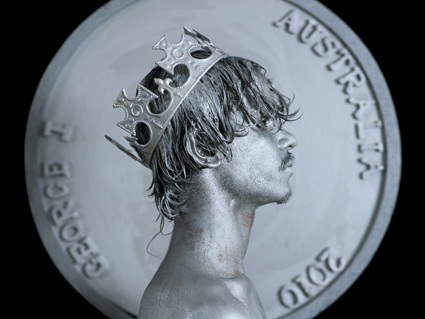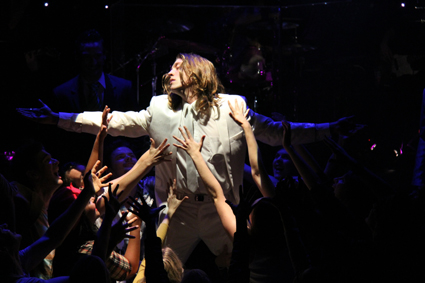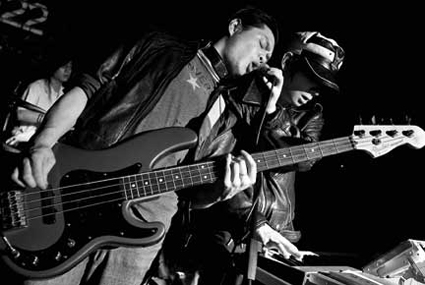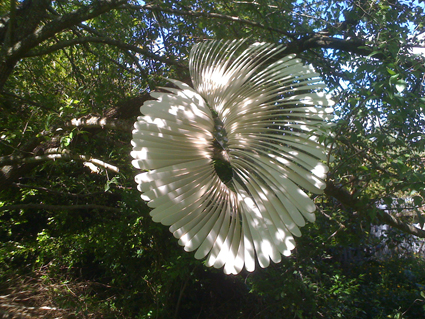January 2012
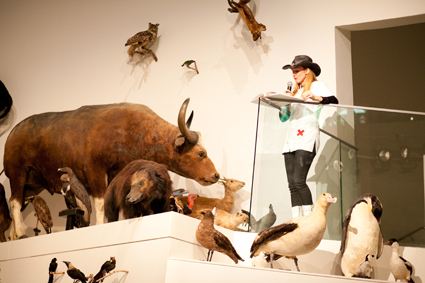
Natalie Jeremijenko, Wilderness Adventures for the Palate, Melbourne Museum
photo Giorgia Maselli
Natalie Jeremijenko, Wilderness Adventures for the Palate, Melbourne Museum
AROUND MID-WAY THROUGH WILDERNESS ADVENTURES FOR THE PALATE, THE COCKTAIL PARTY GUESTS ARE SHEPHERDED DOWN A SWEEPING STAIRCASE INTO THE MELBOURNE MUSEUM’SWILD: AMAZING ANIMALS IN A CHANGING WORLD EXHIBITION, WHERE WE AWAIT THE THIRD OF FOUR DELICIOUS AND CURIOUS EDIBLE/DRINKABLE ARTWORKS. LINING THE BRIGHT, WHITE WALLS OF THE BUNKER-LIKE CHAMBER ARE EVERY KIND OF TAXIDERMIED ANIMAL—FROM MINUSCULE FINCHES TO BABY RHINOCERI, CURLY-TAILED OPOSSUMS, FERRETS, JUMPING RATS, BEAR CUBS AND BIG CATS—ARRAYED IN AN UNFAMILIAR JUMBLE THAT COMPLETELY OVERTURNS TAXONOMICAL CONVENTION.
It’s a fittingly ‘re-imagined’ environment in which to experience the ambrosial delights of the second in Natalie Jeremijenko and Mihir Desai’s Cross(X)Species Adventure Club events: a travelling cocktail party through the halls of the museum exploring the economic, material and gastronomic interdependency between “humans and non-humans.” With its companion event, a five-course degustation dinner at Arc One gallery, the Cross(X)Species Adventure Club is designed to enlist tongues and tastebuds in an “art experience” that is by turns conceptual, performative, aesthetic and sensual.
The Cross(X)Species Adventure Club is one of a cornucopia of “prescriptions” developed by New York University’s Environmental Health Clinic, headed by prodigious scientist/engineer/artist Jeremijenko. Instead of pharmaceuticals, the Environmental Health Clinic prescribes a range of environmental actions and artistic interventions that trigger new thinking or explore unusual technological innovations.
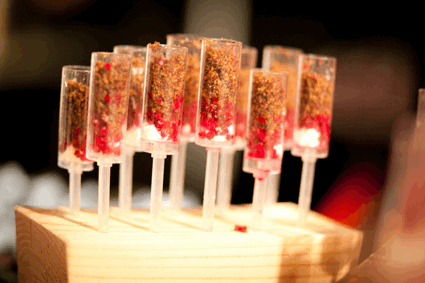
Wilderness Adventures for the Palate, Melbourne Museum
photos Giorgia Maselli
Wilderness Adventures for the Palate, Melbourne Museum
The Museum’s Mind and Body Gallery, where the Wilderness Adventures begin, is all warm wood tones and soft glowing lights, echoing the mood of our first cocktail—a dark blood-coloured “Transfusion” of beet juice, vodka-infused shiraz and brandy. It’s tingly, slightly sweet and tastes distinctly of earth. Jeremijenko appears on a platform jutting out over the central atrium.
In black cowboy hat, white short-sleeved lab smock, black leggings and white boots, she explains the quality of the Victorian-Pyrenees-grown shiraz grapes, fermented to hold their subtle soil taste, describing the alcohol itself as “an amazing collaborator” with its living bacteria and yeast, and its ability to distil the most subtle of flavours. The vibe is not quite party and not quite performance—indeed when I speak with Jeremijenko about her work, she is adamant that she is not a performer.
Soon, a second cocktail—“Soiled Goods”—is served in a syringe-like tube and plunger: it’s strangely gritty, a sort of fetishistic tapenade which the curious audience self-dispenses into what Jeremijenko calls “our landscape-transforming mouths, and the instrument, our tongues.”
Jeremijenko’s collaborator for the Cross(X)Species Adventure Club is New York-based chef Mihir Desai. Prior to their being brought to Australia by environment/sustainability-focused arts producer Carbon Arts, the two have held their eco-inspired supper club in New York and Boston galleries, using ingredients ranging from edible flowers to snails. At the cocktail party, the medium of their collaboratively developed menu is in one sense the message, with its presentation of new, sustainable food options. At the same time, within the context of the event itself, the tastes become a kind of sensory shorthand, themselves summarising the detailed stories Jeremijenko tells about ingredients, supply chains and the specific environmental consequences of making alternative food choices.
When I speak with her prior to the events, Jeremijenko suggests that urban agriculture is “the space race of the 21st century.…it’s a complex systems design issue of how to produce food in an urban context and how to reintegrate vegetation back into the hard surfaces and the excessive structures that we’ve created,” she says. With the verbal knack of a high-tech entrepreneur, she outlines concepts such as “ag-bags”—another of the Environmental Health Clinic’s “prescriptions.” Made of non-degrading Tyvek slung across apartment building balconies and facades and linked by rain-guides, ag-bags are, she says, a kind of “luxury accommodation for snails” that “create arable territory out of thin air.”
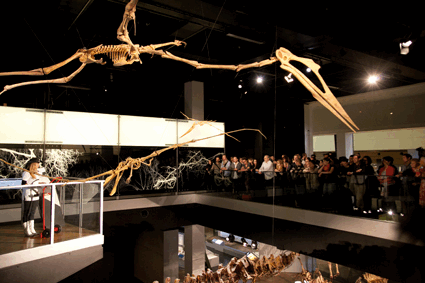
Natalie Jeremijenko, Wilderness Adventures for the Palate, Melbourne Museum
photos Giorgia Maselli
Natalie Jeremijenko, Wilderness Adventures for the Palate, Melbourne Museum
Which brings us back to the Evolution Gallery and that third cocktail. Amid the bevy of still and video cameras (at times it feels like an over-paparazzied reception), waiters weave about with trays of long test tubes filled with a frothy white mix called “MaMa’s milk”—described by Jeremijenko as a tribute to the DaDa movement. The key ingredients are water-buffalo milk, milk thistle extract and snail foam.
Jeremijenko explains that water-buffalo milk is high in protein and fats and very creamy, and that if there were a demand for it, there would also be a demand for wetland. Milk thistle extract is capable of transforming cancerous lung cells to normal cells, she explains. And in case we’re in any doubt, snail milk, or foam, has high-value anti-wrinkle properties. The audience sucks at the test tubes, imbibing the creamy, slightly citrusy concoction and reflecting on the non-human ‘collaborators’ that have contributed to the treat.
The Cross(X)Species Adventure Club, says Jeremijenko, brings attention to alternative foods rather than competing with “the people growing vegetables and tomatoes and basil…We have a repertoire – a whole set of descriptions of edible flowers and berries and what I would call high-commercial-value, high-nutrition-value, highly perishable, non-distributable goods.
“When you pick a black pansy—the blackest flower ever bred—like many edible flowers, the delicate volatiles disappear within a few minutes of picking it. So how do you use these very perishable goods? There are a whole lot of methods: recipes for flash-infusing black pansies into vodka, right? So you can capture these ephemeral tastes that are very different from the kinds of foods that we’ve designed for storage in warehouses and on supermarket shelves and distributing through diesel trucks and shipping containers…”
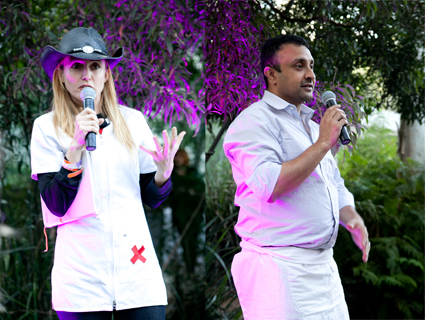
Natalie Jeremijenko & Mihir Desai, Wilderness Adventures for the Palate, Melbourne Museum
photos Giorgia Maselli
Natalie Jeremijenko & Mihir Desai, Wilderness Adventures for the Palate, Melbourne Museum
Jeremijenko describes the “goose dinner” she created with Desai and chef/artist Deborah Solomon in Amsterdam: “So the goose dinner…was not where we ate the goose but where we ate what geese eat, these beautiful foods. Mihir is particularly interested in molecular gastronomy, which really looks at how science can make the processes and transformations in the kitchen very explicit, and with that, intensified tastes; and we can use new techniques to revisit, to reimagine familiar foods.”
The final offering of Wilderness Adventures for the Palate is served beneath the swaying eucalypts of the outdoor Forest Gallery. “Wetkisses” is a delicate, violet “vegan marshmallow” created with West Winds gin, crème de violette, LV methylcellulose, lemon and lime and dusted in something called “bio-char.” Once again we ingest the intriguing mix of ingredients while Jeremijenko explains their relationship to the damaging chytrid fungus, frogs and carbon sequestration.
While Wilderness Adventures of the Palate feels more like an art opening than ‘art,’ Jeremijenko’s introductions reveal the cocktails as unique, conceptual pieces—works that require us to deploy senses rarely called upon for art experiences. There are significant ironies in Jeremijenko’s approach: cocktail parties and degustation dinners are luxury experiences, even as vehicles to inspire and propagate new discourse about sustainability. And she herself notes that on subjects deemed ‘scientific,’ such as global warming, no one is rushing to listen to the views of an artist.
But Natalie Jeremijenko’s work is about individuals, she says, aimed at reversing the once useful strategy of making environmental issues ‘global’ enough to be newsworthy: “You can’t by definition do anything about global warming or global biodiversity. So instead of it being about polar bears and melting ice somewhere else, it’s about the air quality in this room and the food that you’re ingesting and the very direct way in which the shared environmental commons actually affects your own health—so that shifts us away from this internal, atomised, very pharmaceutical, genetically predisposed view of health.
“Not many people say ‘Oh yummy, a hearty meal of edible flowers’—so it’s really an opportunity to create food that is delicious and nutritious to humans and non-humans alike.”
Wilderness Adventures for the Palate, part of the Cross(X)Species Adventure Club, artist Natalie Jeremijenko, molecular gastronomist Mihir Desai, presented by Carbon Arts; Melbourne Museum, Dec 1, 2011; www.environmentalhealthclinic.net/projects/xspecies; www.carbonarts.org
This article first appeared as part o RT’s online e-dition Jan 31, 2012
RealTime issue #107 Feb-March 2012 pg. 12-13
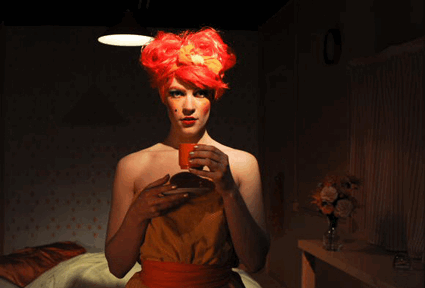
Beguiled, PACT Centre for Emerging Artists
photos Heidrun Löhr
Beguiled, PACT Centre for Emerging Artists
“CHOOSE TO BE LOST. CHOOSE TO BELIEVE,” IS THE 2011 PACT ENSEMBLE’S EXHORTATION IN PREPARATION FOR EXPERIENCING THE ENTRANCING BEGUILED. THE SAME WEEK I ATTENDED SHH’S HOW TO LOSE SIGHT, A MEDITATION ON “BLIND REALITY—LIFE AND LIVING, LOVE AND LOVE-MAKING.” BOTH WERE STEADY, DETAILED, SITE-FOCUSED THEATRE EXPERIENCES FROM SYDNEY’S EMERGING PERFORMANCE MAKERS, CHOOSING TO TACKLE THEIR CENTRAL OBSESSIONS BY WAY OF SENSORY SMORGASBORD AND BOLD THEMATIC EXTRAPOLATION.
beguiled, pact
Under the mentorship of Cat Jones and Julie Vulcan, the PACT Ensemble references magic and illusion to draw us into a series of performative vignettes. In the foyer, we are asked to close our eyes as smooth pebbles are gingerly placed in each of our palms, a ritual to re-calibrate our senses before entering. After a pneumatic introductory dance, the audience is funnelled into three groups.
First, I peek into a blindingly orange boudoir inhabited by an equally orange-beehived woman whose routine of being tucked into her orange-sheeted bed or drinking orange juice and tending to her orange is played out by doppelgangers Emma White and Kate Brown in alternating tableaux. Meanwhile, blood-curdling screams pierce sealed walls from a stairwell. They’re revealed to be those of a twine-wrapped woman (Tanya Thaweeskulcha) who barely contains her breathy hysteria, but recovers sufficiently to herd us into the next installation.
Entering a dimly-lit space populated by keys and speaker cones dangling from ribbons, we are entranced by Madison Chippendale’s determined search for the right key to a door in front of her while pre-recorded whispers express her hidden frustration. Following this, Annabelle McMillian’s playful interaction with a miniature projection of herself on a cardboard diorama is the night’s visual standout.
At the end, the performers reunite the audience by inviting us to lie down and softly gaze at an amorphous video image above, leaving us to slip into a hypnotic daze or light slumber. On reflection, Beguiled’s attempt to engage with the dark arts rarely went beyond a visually-polished techno-vaudevillian showcase, but offered some new voices and idiosyncratic talents, supported by a haunting ambience courtesy of Melissa Hunt’s sound and Emma Lockhart-Wilson’s lighting design.
how to lose sight, shh hybrid arts
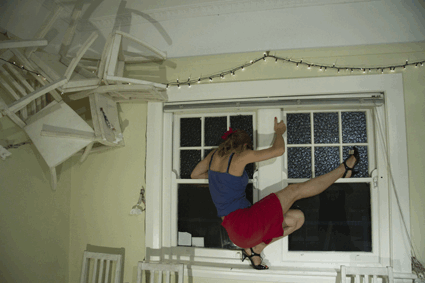
How To Lose Sight, Shh Hybrid Arts
photos Michal Imelski
How To Lose Sight, Shh Hybrid Arts
Over four weeks in a heritage-listed bungalow in Parramatta, Michal Imielski, has led a troupe of sighted-performers through a body of research about blindness accumulated through interviews conducted at Vision Australia. The result is How to Lose Sight, a deeply voyeuristic offering that conflates the idea of blind existence with raw sensuality.
To limit the number of bodies inhabiting tight spaces we are split into four groups by our guide Pollyanna Nowicki. The first is a room filled with an intricate white crocheted web, gently imprisoning us while Odile Leclezio, also in virtuous white, with lifeless eyes but impassioned voice, regales us with anecdotes of her intimate escapades. Meanwhile, her black-suited aides Julia Landrey and Gideon Payton-Griffiths manhandle her through the malleable thread sculpture as she obsessively stuffs white plastic bowls into various sections of the web.
Next, we are subjected to the passionate goings-on between Shauntelle Benjamin and Peter Maple. In silence on the house’s front porch, we watch the work’s gradual commencement with anticipation through the window. As we collectively wish they’d ‘get a room,’ the randy couple swiftly migrates to ours and escalates to near-consummation with a total lack of self-consciousness, evoking a Dogme-esque depiction of sexuality à la The Idiots. Almost on cue, Nowicki provides a most irreverent and innocuous interruption, wielding an iPhone to capture the couple in action and to move the story along.
A pivotal scene takes place in the main living area, where the couple and Barton Williams forensically reconstruct, via a game of charades, an altercation that leads to a chemical blinding. This compelling moment of exposition occurs around a vulvic/eye-like tent, around which the audience are seated and inside which this time more watered-down physical shenanigans are hinted at.
The final room is inhabited by dancer Cloe Fournier who, with eyes tightly shut, flails both manically and methodically amidst chairs in varying states of disrepair. In keeping with the sexually charged energy of the night, she literally climbs the walls (and window ledges) as she voices her desire for amorous attention. After munching on some carrots, she isolates me from the audience and leaves me with souvenirs of flattery and flora, sending me, with a big grin on my face, back out to the audience converged on the front porch.
In the director’s notes, Imielski describes a stint as a close-up magician in a restaurant, during which he converses with a restaurant patron who relates her story of losing sight. As an aspiration to honour the impact of this encounter, Imelski and his team have responded with a work courageous in its imagery and darkly hilarious in its humanity.
PACT, Beguiled, directors Cat Jones, Julie Vulcan, performers/co-devisors Taryn Brine, Kate Brown, Madison Chippendale, Cameron Ellis, Sam Koh, Annabelle McMillan, Lucille Lehr, Tanya Thaweeskulcha, Emma White, Amber Wilcox, sound design and composition Melissa Hunt, lighting design Emma Lockhart Wilson, design Lucy Thornett, PACT Centre for Emerging Artists, Sydney, Nov 23-Dec 10, 2011; www.pact.net.au
Shh Hybrid Arts’ in association with Blacktown Arts Centre, How to Lose Sight, director/composer Michal Imielski, performers/co-devisors Barton Williams, Cloe Fournier, Julia Landrey, Odile Leclezio, Gideon Payten-Griffiths, Peter Maple, Pollyanna Nowicki, Shauntelle Benjamin, designer Lucy Wang, movement advisor Cloe Fournier, Riverside Parramatta and heritage house, Nov 30-Dec 10, 2011; www.shh.org.au/
RealTime issue #106 Dec-Jan 2011 pg. web
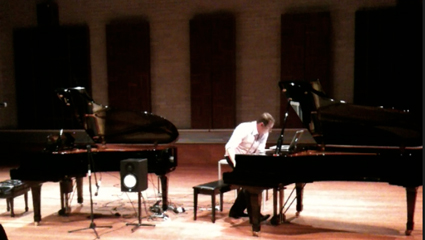
Mark Gasser performing Cat Hope’s Chunk, The Mechanical Piano
photo courtesy the artists
Mark Gasser performing Cat Hope’s Chunk, The Mechanical Piano
THE YAMAHA DISKLAVIER IS BILLED AS THE PLAYER PIANO OF THE DIGITAL AGE. IT LOOKS AND SOUNDS EXACTLY LIKE A TRADITIONAL GRAND PIANO BUT CAN ALSO SEND AND RECEIVE MIDI MESSAGES. THIS ALLOWS FOR A MORE INVOLVED MUSICAL WORKOUT THAN IS POSSIBLE FROM A HUMAN PERFORMER, AS DEMONSTRATED BY THE MECHANICAL PIANO PROGRAM CURATED BY LINDSAY VICKERY LATE LAST YEAR AT THE WEST AUSTRALIAN ACADEMY OF PERFORMING ARTS.
The concert featured a range of approaches to writing for this unique instrument. The most basic of these was the direct playback of a MIDI file by the Disklavier as evidenced in program opener Annie Gosfield’s Bottom of the Barrelhouse. Inspired by barrelhouse pianists, the piece combines dense layers of barrelhouse and boogie-woogie riffs. Collage pieces such as this always prove engaging as the listener tries to identify the component motifs. While the overall dynamic range of the piece was perhaps one-dimensional, it suited the thematic context of the composition.
Mark Gasser took to the stage to add a human element to the proceedings, performing Lindsay Vickery’s Reconstruction of a Shifting Path, premiered at Piano Tapestries as part of the Totally Huge New Music Festival in September last year (see review).In this piece the Disklavier reacts to music performed by the pianist with certain key presses triggering a variety of musical motifs that effectively give the performer extra limbs. The interplay between man and machine results in cascades of notes rippling across the piano keyboard and high speed trills running up the keys in strange arpeggiated patterns. It effectively creates a fascinating visual aesthetic to accompany some beautiful music.
Roland Adeney contributed an audio-visual composition entitled Rat Run. Projecting onto the floor from a ladder, Adeney triggers various video ‘modules’ eliciting a reaction in the Disklavier based on shape and probability-based randomness. The music itself was enjoyable with its one-dimensional language, but the 8-bit visuals were possibly distracting.
Lindsay Vickery’s second contribution to the program, Questions Written on Sheets of Glass, was an improvisation between bass clarinet and piano. Using live computer processing Vickery is able to extract harmonic material from his bass clarinet performance and arrange this as notes on the Disklavier keyboard. The resulting performance created a kaleidoscopic texture with bass clarinet and piano in dynamic interplay.
The first half closed with a performance of Lukas Ligeti’s Delta Space, again featuring Mark Gasser competing with the Disklavier for space in a dense musical landscape. Delta Space was the closest thing to a pop song on the program, featuring a discernible melody amid contemporary urban rhythms disguising the underlying complexity of the music.
Dafna Naphtali’s Landmine set the tone for a noisier second half. Here the piano material was created with the aid of the composer’s own algorithmic programs in a performance that fused acoustic piano with electro-acoustic sampling and manipulation. Despite some initial struggles balancing the sound of laptop processing with the Disklavier, the result was a busy fusion of rich textures that made this one of the most inspired pieces on the program.
Petro Vouris, a student at WAAPA, has recently been investigating ways of using Markov chain probabilities [a mathematical system regarding transitions from one state to another] to rework the relationships between pitch intervals, rhythmic duration and dynamics of a given composition. For this performance Vouris reworked Annie Gosfield’s Bottom of the Barrelhouse creating a new work entitled Bottoms Up. As with the earlier Gosfield work the Disklavier was used to play back a pre-existing MIDI file, but there was no clearly discernible relationship between Vouris’s work and the original. Nonetheless it was an interesting example of how to create a new work utilising an original compositional approach.
The final piece on the program was the premiere of Cat Hope’s Chunk for Disklavier and pianist. Hope utilises the laptop to create a literal translation of her graphic score as piano notes on the Disklavier while pianist Mark Gasser interprets from his own score on a separate piano. The result was one of the loudest acoustic pieces I’ve heard in recent times and effectively pushed both man and machine to their limits, bringing the evening to a close in true rock and roll spirit.
The Mechanical Piano: curator/bass clarinet/laptop Lindsay Vickery, piano Mark Gasser, laptop Roland Adeney; Music Auditorium, West Australian Academy of Performing Arts, Oct 27, 2011
This article first appeared as part of RT’s online e-dition jan 31, 2012
RealTime issue #107 Feb-March 2012 pg. 40
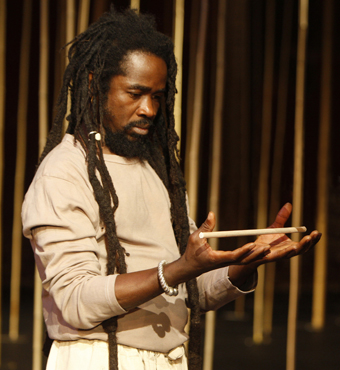
Abdou Ouologuem, A Magic Flute
photo Pascal Victor
Abdou Ouologuem, A Magic Flute
JONATHAN HOLLOWAY, ARTISTIC DIRECTOR OF THE PERTH INTERNATIONAL ARTS FESTIVAL FOR 2012-15, WAS FORMERLY ARTISTIC DIRECTOR AND CHIEF EXECUTIVE OF THE NORFOLK & NORWICH FESTIVAL FOR SIX YEARS. HIS EXPANDED FESTIVAL—ADDING SITE-SPECIFIC WORK, LARGE-SCALE OUTDOOR EVENTS, A CHILDREN’S FESTIVAL, PHYSICAL AND VISUAL THEATRE AND THE VISUAL ARTS—BECAME THE FOURTH LARGEST CITY ARTS FESTIVAL IN THE UK WITH A CORRESPONDING SIGNIFICANT GROWTH IN AUDIENCE NUMBERS.
Previously Holloway had been Creative Director of Elemental, a large-scale theatre, music and spectacle event at the Chalon-sur-Saône festival in France in 2003 and from 1997-2004 he set up and ran the National Theatre’s events department on London’s South Bank, prior to which he had been a theatre director. His first festival for Perth has some strong programming—Lucinda Childs and Peter Brook among others—indicative of Holloway’s art world connections, alongside innovative smaller-scale works that will involve a particpatory audience. I spoke with Holloway about the motivation behind choosing particular artists and works in his program.
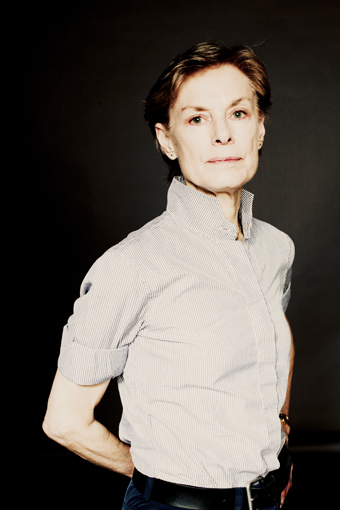
Lucinda Childs 2011
photo Cameron Wittig
Lucinda Childs 2011
What attracted you to invite Lucinda Childs to the festival?
I was having a conversation with Lucinda Childs’ management about programming her work DANCE for the Norfolk and Norwich Festival. I’ve worked with Phillip Glass and have admired Lucinda’s and Sol LeWitt’s work for years. As soon as I realised that she was re-forming her company a year or so ago to remake this seminal work, I immediately started a conversation and when I realised I was coming to Perth, I determined to bring it here. I was delighted that it could be an Australian exclusive as well because it is one of the great pieces.
She’s never brought her own work to Australia. This is one of those defining works of dance—and minimalist dance in particular.
What drew you to Peter Brook’s A Magic Flute?
I saw it in Paris a few weeks after I realised I was coming to Perth. Along with most people, I’ve always been a great fan of Peter Brook’s work and of Mozart’s The Magic Flute. I saw it at the Bouffe du Nord and the fact that it was the final production at the Bouffe du Nord and of the company and the fact that it’s his third and, Brook says, his final opera gave it a real charge and energy.
Then it was the most beautifully simple piece of theatre I’d seen in a long, long time. It strips away all of the layers of interpretation that people put onto the opera. It starts with a flute, a magic flute. And it sounds like an obvious thing to say but there’s something about charging that object and then the simplicity and complexity in the piano accompaniment with the voices in a space that’s almost like a rehearsal room. It’s so intimate and the fact that you’re a few metres away from the singers gives it a level of charge that I’ve never seen in that work before. I’ve seen a lot of work that Peter Brook has produced but this is one of those pieces that really reminds you what he’s about and how he’s at his absolute best when he practises what he preaches about simplicity and energy and theatricality and storytelling.
How pared back is the music?
It’s a piano reduction. In theory it’s less complex than an orchestra but it actually gives it a degree of richness and complexity. Because you’re not overwhelmed by scale, by size, by the physical and aural impact of numbers, what you get is absolute simplicity. This is obviously how it was originally played—by one man sitting at a piano notating a work of absolute genius. It strips the production right back to how it must have sounded the first time it was played. As such, for me it makes it completely timeless. It’s almost opposite to a director’s piece of theatre. Obviously Brook is a great director but his hand is so light throughout the production whereas I’ve seen so many versions of The Magic Flute that were entirely about a theory or an idea or the recreation or re-staging or reinterpretation. This feels more like a conversation between Mozart and Brook.
What about Propeller and their productions of Shakespeare’s The Winter’s Tale and Henry V?
That’s pretty much the opposite of stripped back theatre. It’s rambunctious and energetic. I admire Edward Hall for the idea—he was basically looking at a new way of making Shakespeare fresh, returning to an all-male cast and then cross-casting the productions. There’s a nod towards tradition in that this is the way the works might originally have been performed. But it also feels entirely contemporary. It’s large scale, it’s physical, actors play music, there’s a large set. It’s lush and energetic. As a companion piece to the Peter Brook I think it works really well.
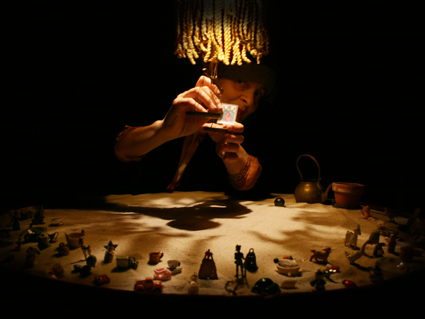
Oraculos, Teatro de los Sentidos
image courtesy Perth International Arts Festival
Oraculos, Teatro de los Sentidos
There are three shows I noted with some interest: Oraculos, Home Sweet Home and Red Ball Project, all works which are very contemporaneous with notions of live art and site specific art which are spreading rapidly on the festival circuit.
Oraculos is created by Teatro de los Sentidos who are from Colombia originally but have been based in Barcelona for some time. It’s designed for one person at a time. You enter a labyrinth. You remove your shoes and walk through a series of little corridors made of cloth and what you experience is 20 something moments or interventions or little scenes or performances or visual installations. Through that journey you receive the answer to the question you may be seeking, whatever that may be. It’s all about you as an audience member. What in life is the big question to which you would like an answer?
So you pose the question as you enter?
When you go in, they ask you to. You’re given a seed to hold and you walk through the labyrinth looking for the answer to your question: it’s about memory; it’s about childhood; it’s about taste and sense and sound and smell. As a result, it enables you to go back and forwards in your life. It’s about life and death. The first work I ever saw by this company was one of the most affecting theatrical experiences I’ve ever had. I came out of it thinking, that’s what site-specific theatre is all about. It’s immersive. It was performed in 1997 at the London International Festival of Theatre [LIFT] and it was one of those works that changed the theatrical landscape. Everyone who’s seen it remembers it and talks about it.
So programming Oraculos was one of the simplest early decisions I made. When I knew I was coming here and I knew the company had never been to Perth, that was the first piece of work I went into bat for. It’s a complex piece of work and because of the scale and the audience, it’s a work where (as festival director) you really have to know why you’re doing it—a performance that runs for 23 days for a total of 1,000 people. But it’s about the depth charge, taking an audience member on a journey and the ripple effect of that. We’re working with a group of 16 local artists, theatre makers and arts professionals for a 10-day workshop with the company on the ideas behind the work, how to make site-specific work on this scale. And then four of the people from the workshop will be cast in the show. There are 16 in the company and four will be from Perth. So when the company leaves here, they leave behind something tangible and hopefully transformational.
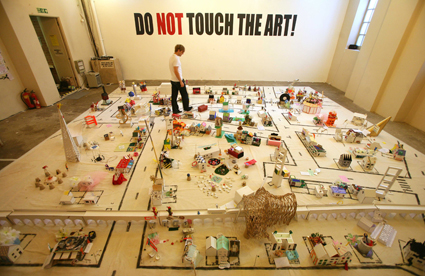
Home Sweet Home installation UK
photo courtesy Perth International Arts Festival the artists
Home Sweet Home installation UK
Speaking of Perth, what kind of city are Subject to Change planning to build with Home Sweet Home?
We don’t know yet. They’ll do a floorcloth, which has a map of the whole of Perth including the outlying areas and suburbs. People come in one at a time, they go to an estate agent and buy a house in whatever area they want. They walk in. It’s a flat pack cardboard house. They build the cardboard house. It’s about 20cms high and then they decorate it and they make whatever Perth they want. It’s an entirely democratic piece of work in which the people of Perth themselves will create the city that they dream of.
Subject to Change is not a company I know.
They’re based in London. They first did this show in Edinburgh. I went along thinking I’d be there for about 10 or 15 minutes. And I sat for about an hour and a half with Michael Kenyon of the Barbican Centre and missed a Michael Clarke performance—we had to go the next night—because we were completely obsessed with making our houses and gardens and creating a better place than the one we had. It captures people’s imagination. This is what festivals do so well, telling the story of a world changed, a world of possibility rather than simply putting up with what we’ve got.
The Red Ball project on the streets of Perth looks intriguing.
Red Ball is from Kurt Perschke in New York. It’s basically what it says. It’s a four and a half metre inflatable red ball jammed into architectural spaces, into alleyways, doorways, bus shelters and buildings. In one instance it’s jammed into a fountain under an overhang. Each day it pops up in a new place. People travel around and catch it, allowing them to see their city in a new light and rediscover bits of the city they might not see on a regular basis. We walk around with our heads down most of the time and anything that can make us look up and see the world around us anew and allow us to fall in love with our city seems like a great thing to do. Red Ball will be in 16 different locations around Perth and Fremantle and Albany.
I was pleased to see you’ve got CIRCA’s How Like Angel premiering before it eventually heads off to the UK. Did you inherit or commission this work for the festival?
It was my idea. I directed a piece of work about 10 years ago in France and had an idea which was going to involve circus and cathedrals. Then I stopped directing. Then a year ago I met with Ruth Mackenzie from the UK Olympics and she asked what I’d like to do for the Olympics. I wasn’t that keen and she said, “what if I gave you this much money, what would you do?” and I said it would be a piece of choral and circus work in sacred spaces. My first call was to [artistic director] Yaron Lifschitz at CIRCA to ask him if he would be interested in doing something like this. Before I’d finished the sentence, he had emailed me with a proposition based on an idea he’d been working on for years for a work performed in cathedrals. So it was one of those great moments when the idea comes from one place but somebody else responds instantly with something you’ve been obsessed about. Between the three approaches, we decided we’d create it and premiere it in Perth and then it will go back to my old festival in Norwich which is going to manage it around the UK.
CIRCA is an extraordinary company. One of the things I like most about their work is their use of music, so the idea of placing them with an eight-piece Renaissance choral ensemble (UK’s I Fagiolini), a turntable and recorded music artist in order to make a soundtrack seemed it would have the same sort of punch as if you’re pulling songs from Jacques Brel or David Bowie or whoever. And to have that live in sacred space! It’s selling gangbusters. It’s really been the surprise hit of the first part of our sales.
Are there other works in the festival program that offer this kind of excitement?
Obviously, the other big project that’s happening is the work by Frantic Assembly and National Theatre of Scotland called Beautiful Burnout that mixes theatre, dance and music by Underworld. I’m also really excited about Driving into Walls, a new work by local company Barking Gecko. They’ve talked to 500 teenagers in WA about what genuinely is their experience of living and growing up here—totally off the record, totally confidentially, and now they’re weaving that all together in a new work written by Suzie Miller. It sounds both exhilarating and totally terrifying. I’m sure it’ll be shocking in terms of its honesty.
Perth International Arts Festival, Feb 10-March 3, perthfestival.com.au
This article first appeared in RT’s online e-dition jan 31, 2012
RealTime issue #107 Feb-March 2012 pg. 8


